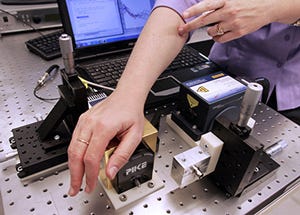How a Laser Could End Diabetic Finger Pricking
August 26, 2014
Researchers at Princeton University have discovered a way to use a laser to measure people's blood sugar, in an effort to eventually shrink the laser into a portable device that could allow for diabetics to eliminate pricking fingers to monitor their condition.
|
The new monitor uses a laser, instead of blood sample, to read blood sugar levels. The laser is directed at the person's palm, passes through skin cells and is partially absorbed by sugar molecules, allowing researchers to calculate the level of blood sugar. (Image courtesy of Princeton University) |
In an article published June 23 in the Biomedical Optics Express, researchers described how they developed a laser that could measure blood sugar levels when directed at a person's palm. The laser passes through the skin cells, without damaging them, and is partially absorbed by the sugar molecules in the patient's body. The researchers could then observe the amount of absorption to measure glucose levels in the bloodstream.
"We are working hard to turn the engineering solutions into useful tools for people to use in their daily lives," Claire Gmachl, the project's senior researcher, said in a recent Princeton news release. "With this work we hope to improve the lives of many diabetes sufferers who depend on frequent blood glucose monitoring."
Gmachl's design is only the latest foray into alternative glucose monitoring devices, as the medical community continues to search for less invasive ways to monitor blood sugar levels. Pricking fingers for those suffering from diabetes can cause calluses, sensitive fingers, and can be difficult for those who have dexterity limitations. These issues can often lead to an aversion to regular glucose monitoring, allowing the condition to worsen. Finding alternative, less invasive ways to monitor glucose levels could revolutionize how those with diabetes manage their disease.
The key to Gmachl's device is the infrared laser's frequency. Mid-infrared light is below the lowest frequency of light that humans can see, but has several useful properties. This frequency is not blocked by water, which enables it to be used on the human body, which is largely made up of water. It also does not interact with many acids and chemicals in the skin, which makes it very practical for detecting blood sugar. The challenge was harnessing mid-infrared light with standard lasers, until Gmachl and her team found a breakthrough from a quantum cascade laser.
The quantum cascade laser enabled researchers to specify the frequency of laser produced, allowing them to project a laser in the mid-infrared region. Recent improvements to the quantum cascade laser also provided increased power and the stability needed to penetrate the skin.
Researchers began testing the laser on three healthy adults before and after they ate 20 jellybeans, which would raise their blood sugar levels. They also measured glucose levels through pricking their fingers, and compared results over several weeks. Researchers said the laser results indicated average errors that were somewhat larger than the standard blood sugar monitors, but remained well within the clinical requirements for accuracy.
Although their research is still being refined, Gmachl hopes that the application of the laser could go well beyond simple glucose monitoring devices.
"Because the quantum cascade laser can be designed to emit light across a very wide wavelength range, its usability is not just for glucose detection," She said. "It could conceivably be used for other medical sensing and monitoring applications."
Related Articles
How Google and Novartis Might Revolutionize Contact Lenses
Apple's iWatch Rumored to Be Held up by FDA
Can Flash Glucose Monitoring Disrupt Diabetes Care (and Revive Abbott's Diabetes Business)?
Refresh your medical device industry knowledge at MEDevice San Diego, September 10-11, 2014. |
Kristopher Sturgis is a contributor to Qmed and MPMN.
Like what you're reading? Subscribe to our daily e-newsletter.
About the Author(s)
You May Also Like


.png?width=300&auto=webp&quality=80&disable=upscale)
